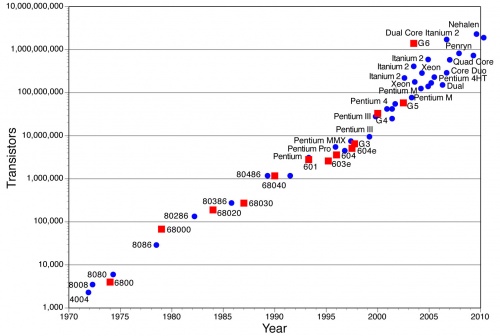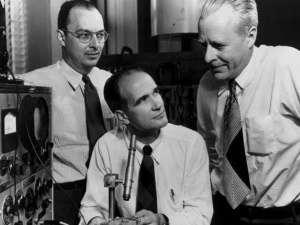Moore's Law
Moore's Law is a phenomenon first observed by Gordon Moore, who was both one of the founders of Fairchild Semiconductor and a former CEO of Intel. The law states, in its most popular form, that the number of transistors on a computer circuit will double every two years [1]. Transistors are a type of semiconductor made up of either silicon or germanium that can manipulate the flow of electrons.[2]
In a more abstract interpretation, Moore’s law refers to the more general principle in computing of constant improvement and the unstoppable evolution of technological efficiency and power. The law implies exponential growth. Because Moore’s law is an observation of a historical trend and not a scientific law like the 1st law of thermodynamics, its definition is more easily manipulated and changed in terms of its content and implications. While generally interpreted as a positive trend, Moore's Law and its underlying ethical implications have become a topic of debate, especially as it pertains to ________, ___________, and ___________.
Contents
Background
Transistors
Computers are fundamentally a collection of electronic switches. These switches that control how electrical charges are routed communicate and represent bits, binary digits, that represent information. The first computers, everything from the Model K to the AVIDAC, used vacuum tubes as switches. Inefficiencies in vacuum tubes’ excess heat generation and tendency to break lead to the creation of transistor.[3] Transistors are much smaller, faster and require less power than the vacuum tube. Transistors were invented by John Bardeen, Walter Brattain, and William Shockley. All three men worked for Bell Laboratories and were awarded the Nobel Prize in Physics in 1956.[4]
Creation and Iterations of Moore's Law
In 1965, Gordon Moore put out a short report that would later become what we know today as Moore’s law. In the paper, titled “Cramming more components onto integrated circuits”, he simply referred to a historical trend, observing that, for a set cost, the number of integrated components has increased a rate of two per year.[5] This means that the number of transistors within a constant physical space will double every year. In this article, he also predicted that this trend would continue until at least 1975.
At the time, the computer chip industry was capable of integrating tens of transistors on a single silicon die, and Moore was projecting the integration of up to “65,000 components on a single silicon chip”.[6] During the IEEE technology conference in 1975, Moore made a revision to his previous statement. Citing new research and advancements, he said that the doubling of transistor density would continue, but at the pace of 18-24 months for the foreseeable future.[7] Shortly after his revision, a professor at CalTech named Calvin Mead gave Moore’s prediction the name we know it as today.
Moore's Law in Other Contexts
Eroom's Law
Eroom’s law is another observation of historical trends, but it uses data derived from the research and development of pharmaceutical drugs. It is virtually the opposite of Moore’s Law. Originally proposed in the Nature Journal,[8] the phenomenon describes, in the last 60 years, how the number of new drugs approved per billion US dollars has halved roughly every 9 years. While computers are becoming exponentially more efficient, drug discovery is becoming exponentially less efficient.
Carlson Curve
Published in a paper titled, “Biology is Technology”,[9] Robert Carlson examined biology as a human technology. In his analysis, he found that, controlling for cost, the performance of technologies including DNA sequencing, DNA synthesis, and a range of other computational tools used in biotechnology has and would continue to double every 2 years.
Moore's Law is Dying
Starting in 2010, Moore’s Law began to slow down for two main reasons.[10] The first is electrical leakage. For the second half of the 20th century, the miniaturization of transistors meant that they would be more energy efficient. Recently, they have gotten so small, even as small as 10 nanometers,[11] that the transistor through which the electronic currents flow cannot always contain it. The second reason is based on economic factors. As transistors get smaller and generate more heat as a result of their instability and greater concentration of units, the amount of infrastructure needed to keep the transistors cool also increases, and the cost of cooling large server rooms is getting more and more expensive.[12] These realities led the CEO of Nvidia to declare Moore’s law to be dead at CES 2019.[13]
Ethical Implications
Moore’s Law, more abstractly, gives a name to the constant, iterative improvement in computational efficiency. This innovation has given us supercomputers in our pockets, the ability to buy household items on an online marketplace and receive them in 2 days, and the means to connect with those who are thousands of miles away. However, as Thomas Friedman writes in his article titled, “Online and Scared” the infosphere is double-edged.[14]
Energy Consumption
One of the nagging, unforeseen consequences of Moore’s Law is energy consumption. As computer chips become more powerful, the amount of power they consume will also increase, as will the ratio of overall human energy consumption that is devoted to computational practices. The ethical implications for this eventuality come from the means by which the energy is being produced. Events like the 3 Mile Island and the Exxon Valdez oil spill are not likely to stop as long as energy demands are increasing. One could argue that those events allowed us to learn from our mistakes, but, as Daniel Dennet writes in Virtues of Ignorance, “can we say, with confidence better than a coin flip, whether 3 Mile Island was one of the good things that have happened or one of the bad?”.[15]
AI
Side-effects of disruptive technology can present themselves in unintended ways. The rapid growth facilitated by Moore’s Law has lead to advancements in AI and automated algorithms, but this rapid growth often goes unchecked and unregulated. In her paper titled, “The ethics of designing artificial agents”,[16] Frances Godzinsky argues that the burden of responsibility for the actions of these artificial agents falls on the human designers. This emphasis on careful thought preceding technological innovation is at odds with the principles that underlie Moore’s Law.
Online Privacy
Moore’s law also speaks to increasing computational efficiencies being coupled with increasing monetary efficiencies. As it becomes more cost effective to aggregate and store massive amounts of information, the tendency to do so increases. One implication of this is that information on the internet doesn’t really get deleted. A lack of control over personal information’s availability online has raised questions of online privacy. Leading ICT ethicist Luciano Floridi writes that the right to privacy is a right to a renewable identity,[17] an idea that doesn't mesh well with the ease of keeping information online that Moore's Law provides.
References
- ↑ https://www.investopedia.com/terms/m/mooreslaw.asp
- ↑ https://www.britannica.com/technology/transistor
- ↑ https://www.pbs.org/transistor/background1/events/sscomputer.html
- ↑ https://www.nobelprize.org/prizes/physics/1956/summary/
- ↑ https://www.cs.utexas.edu/users/fussell/courses/cs352h/papers/moore.pdf
- ↑ https://www.cs.utexas.edu/users/fussell/courses/cs352h/papers/moore.pdf
- ↑ https://www.eng.auburn.edu/~agrawvd/COURSE/E7770_Spr07/READ/Gordon_Moore_1975_Speech.pdf
- ↑ https://www.nature.com/articles/nrd3681
- ↑ http://www.hup.harvard.edu/catalog.php?isbn=9780674060159
- ↑ https://www.techrepublic.com/article/moores-law-is-dead-three-predictions-about-the-computers-of-tomorrow/
- ↑ https://interestingengineering.com/intel-finally-unveils-10nm-cannon-lake-processors
- ↑ https://interestingengineering.com/mark-zuckerberg-releases-hi-tech-photos-facebook-data-center
- ↑ https://www.cnet.com/news/moores-law-is-dead-nvidias-ceo-jensen-huang-says-at-ces-2019/
- ↑ https://www.nytimes.com/2017/01/11/opinion/online-and-scared.html
- ↑ https://www.jstor.org/stable/20025064?seq=1#metadata_info_tab_contents
- ↑ https://link.springer.com/article/10.1007/s10676-008-9163-9
- ↑ https://umich.instructure.com/courses/273552/files/folder/Readings/2%20Weeks%204-7?preview=9617533


